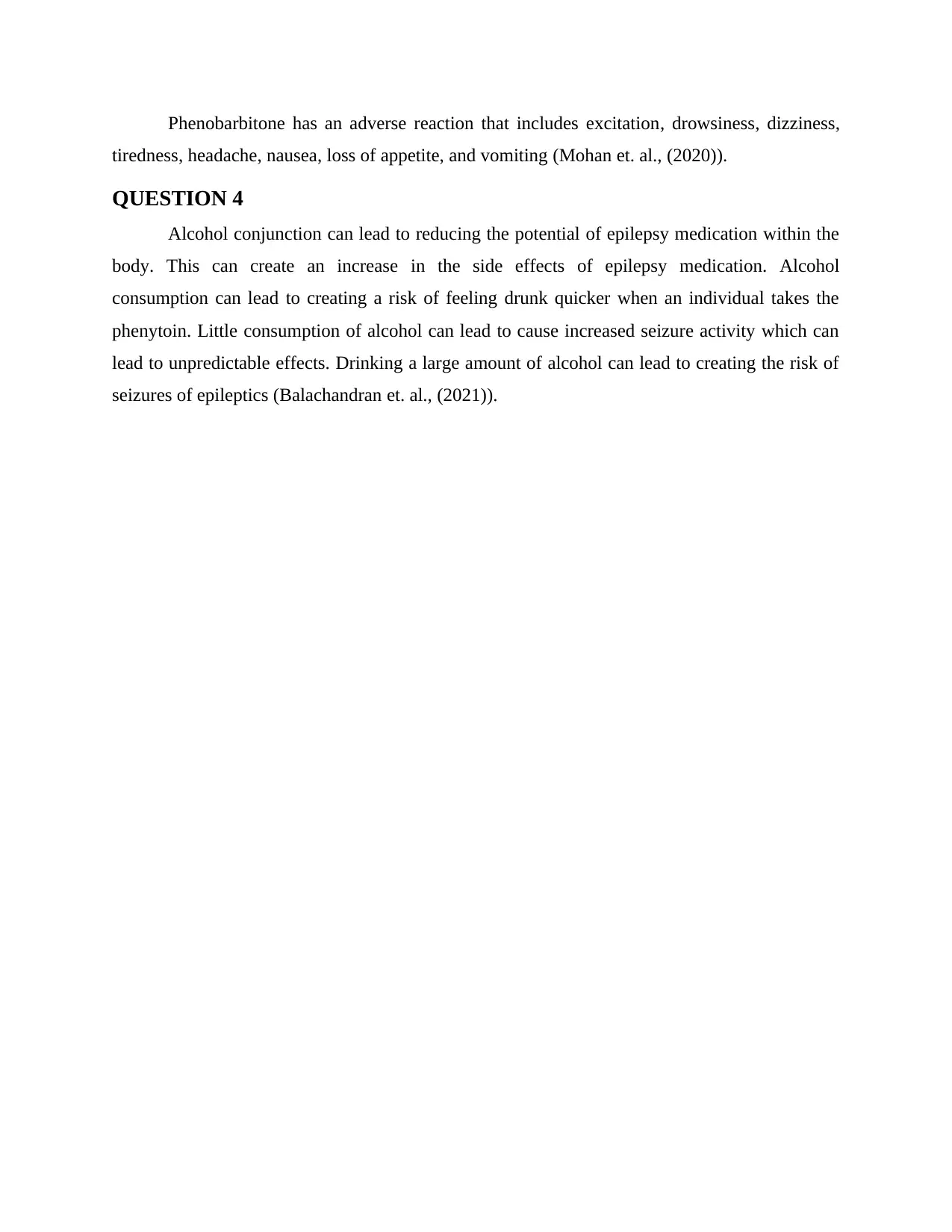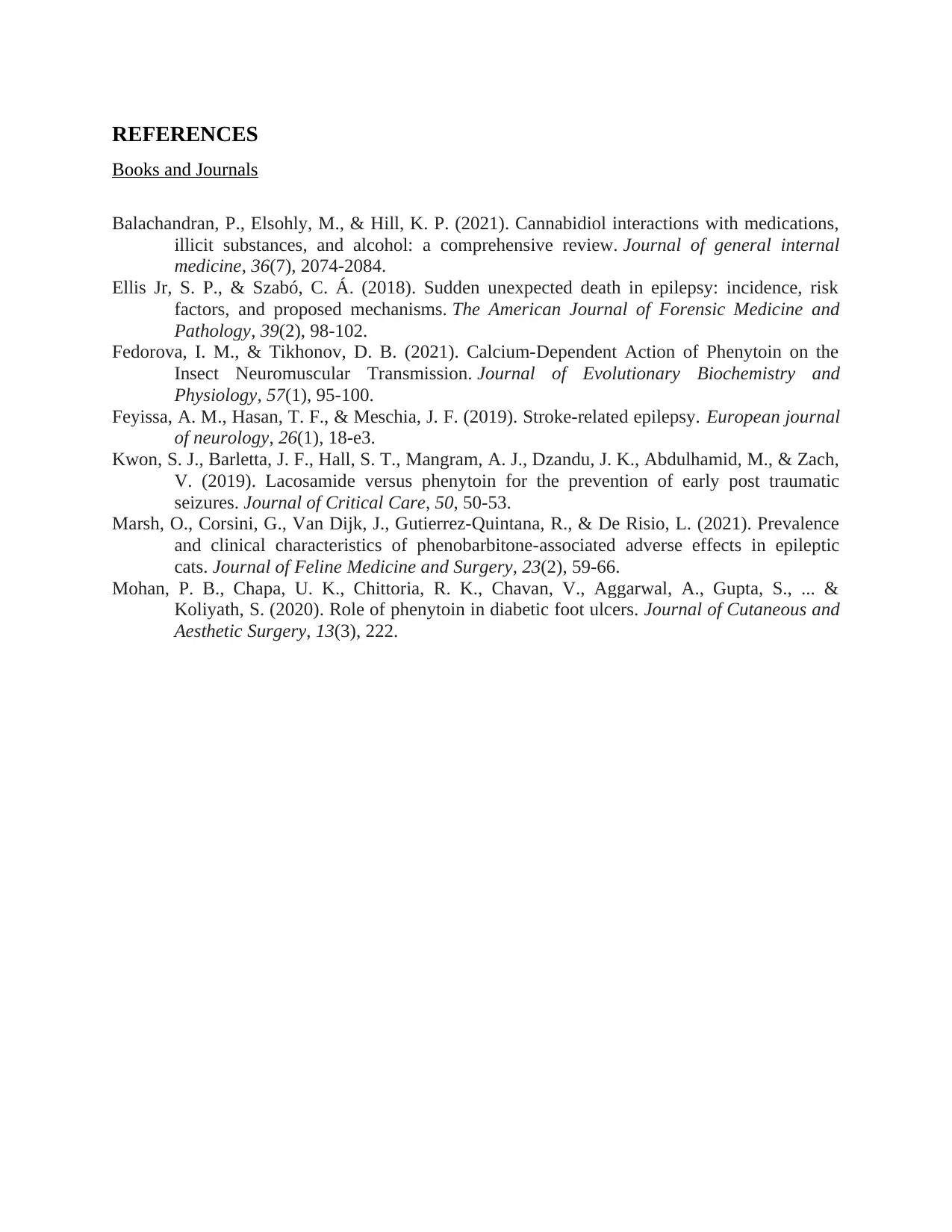John's Epilepsy Case: Treatment, Side Effects & Alcohol Impact
VerifiedAdded on 2023/06/11
|5
|904
|243
Case Study
AI Summary
This case study analyzes the treatment of epilepsy in a patient named John, focusing on the use of phenytoin and phenobarbitone. It identifies head injury as the likely cause of John's secondary epilepsy and explains how phenytoin functions as a non-specific sodium channel blocker, while phenobarbitone, a barbiturate, slows brain activity and increases synaptic inhibition. The study also details the potential adverse reactions of both medications, including gum problems with phenytoin and drowsiness with phenobarbitone. Furthermore, it addresses the risks associated with alcohol consumption during epilepsy treatment, such as reduced medication effectiveness and increased seizure activity. The case study concludes with a list of references used to support the analysis.

John Case Study
Paraphrase This Document
Need a fresh take? Get an instant paraphrase of this document with our AI Paraphraser

Table of Contents
QUESTION 1...................................................................................................................................3
QUESTION 2...................................................................................................................................3
QUESTION 3...................................................................................................................................3
QUESTION 4...................................................................................................................................4
REFERENCES................................................................................................................................5
QUESTION 1...................................................................................................................................3
QUESTION 2...................................................................................................................................3
QUESTION 3...................................................................................................................................3
QUESTION 4...................................................................................................................................4
REFERENCES................................................................................................................................5

QUESTION 1
Different factors can be related to the cause of secondary epilepsy. This factor may
include family history, head injury, dementia, stroke or another vascular disease, brain infection,
seizures in childhood and are most common in adults and children (Ellis Jr et. al., (2018)). Here,
the factor relates to John's case is a head injury which is highly effective and can create a high
impact on John’s brain which can create in one part of the brain and can spread to both sides.
This can include the focal seizures initially and followed by generalized seizures (Feyissa et. al.,
(2019)).
QUESTION 2
Phenytoin has permeability and describes as a non-specific sodium channel blocker. It
can also target all the sodium channels subtypes, and specifications by innovating a positive
feedback loop that can result in neuronal propagation with a high-frequency action potential.
This can protect the individual against seizures by causing voltage-dependent blocks through
voltage-gated sodium channels. It also blocks high-frequency repetitive firing of action potential
(Fedorova et. al., (2021)).
Phenobarbitone is a barbiturate that has the potential to slow the activity of the brain
along with the nervous system. It can help to provide treatment and prevention of seizures. It can
act as a short-term sedative which can help an individual to get relaxed. Phenobarbitone act on
the GABAA receptor which can also increase synaptic inhibition. It can have a fact on elevating
the seizures threshold which can reduce the spread of seizures activity. It can also innovate
calcium channels which can result in decreasing the excited transmitter release (Marsh et. al.,
(2021)).
QUESTION 3
Phenytoin can cause bleeding and swelling of the gums. In this, there is a need to
regularly brush the teeth which can have to minimize such type of problem when an individual is
taking phenytoin as the medication even after the side effect as the gum problem. Even it is
prescribed due to having high benefits than the side effect (Kwon et. al., (2019)).
Phenytoin adverse reaction includes nausea, headache, dizziness, constipation, vomiting,
drowsiness, feeling of spinning, nervousness and trouble sleeping.
Different factors can be related to the cause of secondary epilepsy. This factor may
include family history, head injury, dementia, stroke or another vascular disease, brain infection,
seizures in childhood and are most common in adults and children (Ellis Jr et. al., (2018)). Here,
the factor relates to John's case is a head injury which is highly effective and can create a high
impact on John’s brain which can create in one part of the brain and can spread to both sides.
This can include the focal seizures initially and followed by generalized seizures (Feyissa et. al.,
(2019)).
QUESTION 2
Phenytoin has permeability and describes as a non-specific sodium channel blocker. It
can also target all the sodium channels subtypes, and specifications by innovating a positive
feedback loop that can result in neuronal propagation with a high-frequency action potential.
This can protect the individual against seizures by causing voltage-dependent blocks through
voltage-gated sodium channels. It also blocks high-frequency repetitive firing of action potential
(Fedorova et. al., (2021)).
Phenobarbitone is a barbiturate that has the potential to slow the activity of the brain
along with the nervous system. It can help to provide treatment and prevention of seizures. It can
act as a short-term sedative which can help an individual to get relaxed. Phenobarbitone act on
the GABAA receptor which can also increase synaptic inhibition. It can have a fact on elevating
the seizures threshold which can reduce the spread of seizures activity. It can also innovate
calcium channels which can result in decreasing the excited transmitter release (Marsh et. al.,
(2021)).
QUESTION 3
Phenytoin can cause bleeding and swelling of the gums. In this, there is a need to
regularly brush the teeth which can have to minimize such type of problem when an individual is
taking phenytoin as the medication even after the side effect as the gum problem. Even it is
prescribed due to having high benefits than the side effect (Kwon et. al., (2019)).
Phenytoin adverse reaction includes nausea, headache, dizziness, constipation, vomiting,
drowsiness, feeling of spinning, nervousness and trouble sleeping.
⊘ This is a preview!⊘
Do you want full access?
Subscribe today to unlock all pages.

Trusted by 1+ million students worldwide

Phenobarbitone has an adverse reaction that includes excitation, drowsiness, dizziness,
tiredness, headache, nausea, loss of appetite, and vomiting (Mohan et. al., (2020)).
QUESTION 4
Alcohol conjunction can lead to reducing the potential of epilepsy medication within the
body. This can create an increase in the side effects of epilepsy medication. Alcohol
consumption can lead to creating a risk of feeling drunk quicker when an individual takes the
phenytoin. Little consumption of alcohol can lead to cause increased seizure activity which can
lead to unpredictable effects. Drinking a large amount of alcohol can lead to creating the risk of
seizures of epileptics (Balachandran et. al., (2021)).
tiredness, headache, nausea, loss of appetite, and vomiting (Mohan et. al., (2020)).
QUESTION 4
Alcohol conjunction can lead to reducing the potential of epilepsy medication within the
body. This can create an increase in the side effects of epilepsy medication. Alcohol
consumption can lead to creating a risk of feeling drunk quicker when an individual takes the
phenytoin. Little consumption of alcohol can lead to cause increased seizure activity which can
lead to unpredictable effects. Drinking a large amount of alcohol can lead to creating the risk of
seizures of epileptics (Balachandran et. al., (2021)).
Paraphrase This Document
Need a fresh take? Get an instant paraphrase of this document with our AI Paraphraser

REFERENCES
Books and Journals
Balachandran, P., Elsohly, M., & Hill, K. P. (2021). Cannabidiol interactions with medications,
illicit substances, and alcohol: a comprehensive review. Journal of general internal
medicine, 36(7), 2074-2084.
Ellis Jr, S. P., & Szabó, C. Á. (2018). Sudden unexpected death in epilepsy: incidence, risk
factors, and proposed mechanisms. The American Journal of Forensic Medicine and
Pathology, 39(2), 98-102.
Fedorova, I. M., & Tikhonov, D. B. (2021). Calcium-Dependent Action of Phenytoin on the
Insect Neuromuscular Transmission. Journal of Evolutionary Biochemistry and
Physiology, 57(1), 95-100.
Feyissa, A. M., Hasan, T. F., & Meschia, J. F. (2019). Stroke‐related epilepsy. European journal
of neurology, 26(1), 18-e3.
Kwon, S. J., Barletta, J. F., Hall, S. T., Mangram, A. J., Dzandu, J. K., Abdulhamid, M., & Zach,
V. (2019). Lacosamide versus phenytoin for the prevention of early post traumatic
seizures. Journal of Critical Care, 50, 50-53.
Marsh, O., Corsini, G., Van Dijk, J., Gutierrez-Quintana, R., & De Risio, L. (2021). Prevalence
and clinical characteristics of phenobarbitone-associated adverse effects in epileptic
cats. Journal of Feline Medicine and Surgery, 23(2), 59-66.
Mohan, P. B., Chapa, U. K., Chittoria, R. K., Chavan, V., Aggarwal, A., Gupta, S., ... &
Koliyath, S. (2020). Role of phenytoin in diabetic foot ulcers. Journal of Cutaneous and
Aesthetic Surgery, 13(3), 222.
Books and Journals
Balachandran, P., Elsohly, M., & Hill, K. P. (2021). Cannabidiol interactions with medications,
illicit substances, and alcohol: a comprehensive review. Journal of general internal
medicine, 36(7), 2074-2084.
Ellis Jr, S. P., & Szabó, C. Á. (2018). Sudden unexpected death in epilepsy: incidence, risk
factors, and proposed mechanisms. The American Journal of Forensic Medicine and
Pathology, 39(2), 98-102.
Fedorova, I. M., & Tikhonov, D. B. (2021). Calcium-Dependent Action of Phenytoin on the
Insect Neuromuscular Transmission. Journal of Evolutionary Biochemistry and
Physiology, 57(1), 95-100.
Feyissa, A. M., Hasan, T. F., & Meschia, J. F. (2019). Stroke‐related epilepsy. European journal
of neurology, 26(1), 18-e3.
Kwon, S. J., Barletta, J. F., Hall, S. T., Mangram, A. J., Dzandu, J. K., Abdulhamid, M., & Zach,
V. (2019). Lacosamide versus phenytoin for the prevention of early post traumatic
seizures. Journal of Critical Care, 50, 50-53.
Marsh, O., Corsini, G., Van Dijk, J., Gutierrez-Quintana, R., & De Risio, L. (2021). Prevalence
and clinical characteristics of phenobarbitone-associated adverse effects in epileptic
cats. Journal of Feline Medicine and Surgery, 23(2), 59-66.
Mohan, P. B., Chapa, U. K., Chittoria, R. K., Chavan, V., Aggarwal, A., Gupta, S., ... &
Koliyath, S. (2020). Role of phenytoin in diabetic foot ulcers. Journal of Cutaneous and
Aesthetic Surgery, 13(3), 222.
1 out of 5
Related Documents
Your All-in-One AI-Powered Toolkit for Academic Success.
+13062052269
info@desklib.com
Available 24*7 on WhatsApp / Email
![[object Object]](/_next/static/media/star-bottom.7253800d.svg)
Unlock your academic potential
Copyright © 2020–2025 A2Z Services. All Rights Reserved. Developed and managed by ZUCOL.





